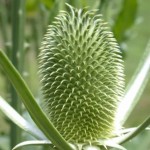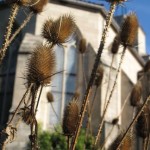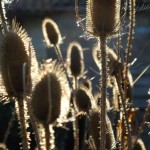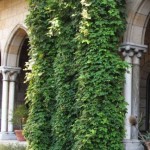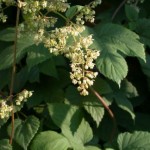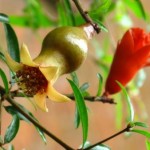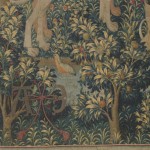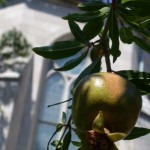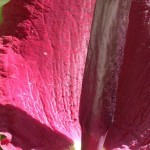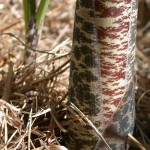Archive for the ‘Medicinal Plants’ Category
Friday, October 16, 2009
Above, from left to right: The seed head of the cultivated form of teasel (Dipsacus sativus) in a bed devoted to plants used in medieval arts and crafts (2006); detail of the seed head of the teasel growing in the same bed this year; detail of the seed head of common teasel, or fuller???s teasel (D. fullonum),??now in the medicinal bed.
Visitors to Bonnefont Garden are often surprised to find plants that they recognize as common weeds being carefully cultivated in the beds here. One ubiquitous weed found growing in waste places throughout this country is the common or wild teasel, Dipsacus fullonum, a plant which had various medicinal applications in the European Middle Ages. Read more »
Tags: Dipsacus fullonum, Dipsacus sativus, fuller???s teasel
Posted in Gardening at The Cloisters, Medicinal Plants, Useful Plants | Comments (6)
Thursday, October 1, 2009
Above, from left to right: Hop bines grown in Bonnefont Cloister garden send out new shoots in March, reaching the roofline by the end of May and dying back to the ground in late autumn; a hop bine bearing female flowers, called cones, adorns the abacus of a column from Saint-Guilhem Cloister; detail of a bine bearing a male flower.
Hop (Humulus lupulus) has been used as a vegetable (according to the Roman natural historian Pliny, the young shoots of the plant were eaten), as both fodder and bedding for cattle, as a dye, and, like its close relative hemp (Cannabis sativa), as a fiber plant. It also appears as a medicament in medieval and Renaissance herbals. The fifteenth-century Herbarius Latinus recommends hops for purifying the blood, opening obstructions of the spleen, easing fever, and curing both headache and jaundice. However, the most important economic use of hops in the Middle Ages and at the present writing is in brewing beer. Read more »
Tags: beer, bine, brew, cannabis sativa, dioecious, hemp, hop, humulus lupulus
Posted in Food and Beverage Plants, Gardening at The Cloisters, Medicinal Plants, Useful Plants | Comments (0)
Wednesday, September 16, 2009
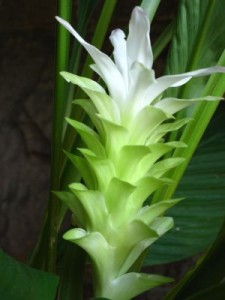
Turmeric (Curcuma longa), a native of India, flowering in the arcade of Bonnefont Cloister. Turmeric and other tender exotics in the collection are grown in pots.
The plant collection at The Cloisters includes a number of exotic species that would not have been??grown in medieval European gardens, but whose dried roots, seeds, bark, or other parts were imported for use in food and medicine. Read more »
Tags: Curcuma longa, turmeric, Zingiberaceae
Posted in Food and Beverage Plants, Gardening at The Cloisters, Medicinal Plants | Comments (0)
Friday, August 14, 2009
Above, from left to right: Calendar page for August from the Belles Heures of Jean de France, Duc de Berry, 1405???1408/1409. Pol, Jean, and Herman de Limbourg (Franco-Netherlandish, active in France, by 1399???1416). French; Made in Paris. The Metropolitan Museum of Art, New York, The Cloisters Collection, 1954 (54.1.1); detail of the activity for the month; detail of the zodiacal symbol Virgo. See the Collection Database to learn more about this work of art.
Sometimes busy, bound by rings,
I must eagerly obey my servant,
Break my bed, clamor brightly
That my lord has given me a neck-ring.
Sleep-weary I wait for the grim-hearted
Greeting of a man or woman; I answer
Winter-cold. Sometimes a warm limb
Bursts the bound ring, pleasing my dull
Witted servant and myself. I sing round
The truth if I may in a ringing riddle.
???Anglo-Saxon riddle from The Exeter Riddle Book, translated by Craig Williamson
Read more »
Tags: August, flail, sweple, threshing, Virgo, wheat
Posted in Medicinal Plants, Medieval Agriculture, The Medieval Calendar | Comments (5)
Friday, July 31, 2009
Above, from left to right: A potted dwarf pomegranate flowering and fruiting now; a detail of a pomegranate tree depicted in The Unicorn Is Attacked; a full-sized pomegranate ripening on a tree set in the ground in Bonnefont Garden. Pomegranates are deciduous; the leaves turn a bright yellow before falling in October. By the Middle Ages, the exotic??eastern fruit had long been cultivated in southern Europe. Although it is not cold-hardy,??pomegranate has been grown in the gardens of The Cloisters from their beginnings.
I went down into the nut orchard,
to look at the blossoms of the
valley,
To see whether the vines had budded,
whether the pomegranates were
in bloom.
Before I was aware, my fancy set me
in a chariot beside my prince.
???Song of Solomon 6:11 and 12 (Revised Standard Version)
Read more »
Tags: antioxidant, fertility, fruit, pomegranate, Punica granatum, Unicorn tapestries
Posted in Food and Beverage Plants, Medicinal Plants, Plants in Medieval Art | Comments (8)
Friday, May 29, 2009
Above, from left: dragon arum (Dracunculus vulgaris) growing in Bonnefont garden; detail of the spathe and spadix common to arums; detail of the reptilian markings on the stems.
Arums and other members of the botanical family Araceae are fly pollinated, and their flowers imitate both the color and the smell of rotting meat in order to attract pollinators. The little cuckoo-pint featured in last week???s post is by no means the most fetid member of the family. Cuckoo-pint???s enormous tropical cousin, Amorphophallus titanum, notorious for its overpowering stench, is native to Sumatra.?? The titan arum??is also cultivated in conservatories and gains worldwide attention when it blooms in botanical gardens like Kew. Read more »
Tags: aphrodisiac, Arum maculatum, cuckoo-pint, Dracunculus vulgaris, dragon arum, spadix, spathe
Posted in Botany for Gardeners, Magical Plants, Medicinal Plants | Comments (4)
Friday, May 15, 2009
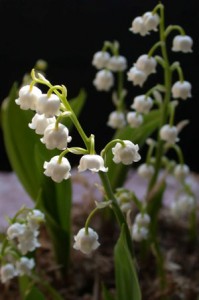
Above: Lily of the valley (Convallaria majalis)
White coral bells upon a slender stalk
Lilies-of-the-valley deck my garden walk. . . .
???Traditional English Round
In spite of its medieval association with the exotic Queen of Sheba (see last week’s post), this modest, northern European woodland flower is actually as easy to grow as it is familiar. Read more »
Tags: Convallaria majalis, lily of the valley
Posted in Botany for Gardeners, Fragrant Plants, Gardening at The Cloisters, Medicinal Plants, Plants in Medieval Art | Comments (7)
Friday, May 8, 2009
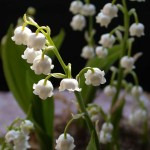
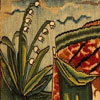
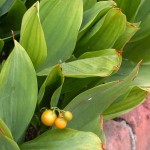
Above, from left to right: Detail of a potted lily of the valley forced for early display in Cuxa cloister; Detail of the tapestry The Queen of Sheba before King Solomon from Two Riddles of the Queen of Sheba; Lily of the valley fruiting in Bonnefont Garden in late summer.
I am the flower of the field,
And the lily of the valleys.
As the lily among thorns, so is
My love among the daughters.
???Canticle of Canticles (Song of Songs) 2:1-2
The lily and the rose are the chief adornments of the allegorical hortus conclusus, the enclosed garden of the Virgin rooted in the language of the Song of Songs in the Old Testament. Read more »
Tags: Convallaria majalis, lily of the valley, May, Solomon and Sheba, Song of Songs, Virgin
Posted in Gardening at The Cloisters, Medicinal Plants, Plants in Medieval Art | Comments (2)
Thursday, April 9, 2009
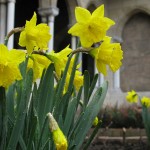
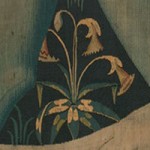
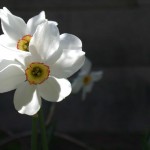
Above, from left to right: Rain-drenched daffodils in Bonnefont Cloister garden; a detail from The Hunters Enter the Woods; the later-blooming pheasant???s eye narcissus.
The daffodil now flourishing in Bonnefont Garden is not the wild Lent lily, Narcissus pseudo-narcissus, but a subspecies, N. pseudo-narcissus obvallaris, known as the Tenby daffodil. The parent species, N. pseudonarcissus, the daffodil of the Middle Ages, was not available to us at planting time last fall, but we will obtain stock this year. We had long believed the bulbs that we obtained every year from a Dutch bulb company to be the wild Lent lily. When that particular company ceased to stock the bulbs, we began to look for other sources. I had a conversation with Scott Kunst, a noted expert on historical bulbs, who doubted that what we had been planting had been the true N. pseudonarcissus. Read more »
Tags: daffodil, Narcissus, narcissus pseudonarcissus, Narcissus pseudonarcissus ssp. obvallaris, Tenby daffodil
Posted in Medicinal Plants | Comments (7)
Friday, March 13, 2009
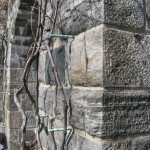
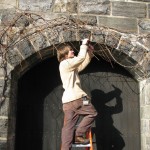
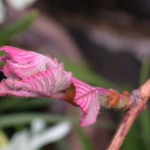
Above, from left to right: Grapevines have long been trained against the south-facing wall of the courtyard; Kevin Wiecks prunes last year???s growth back to a few dormant buds; the pink of the new foliage is transitory but beautiful.
Wine and wine grapes were of great economic and symbolic importance in the Middle Ages. Vineyards were associated both with royal and noble estates and with monasteries. Medieval wines were drunk new, and spiced wines, or piments, were also enjoyed. Wine was not only a beverage but a medicament, and the Tacuinum Sanitatis recommends grapes as a purifying and nourishing food. Read more »
Tags: grapes, grapevine, pruning, Vitis vinifera
Posted in Food and Beverage Plants, Gardening at The Cloisters, Medicinal Plants | Comments (1)
